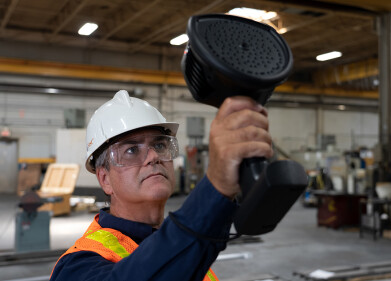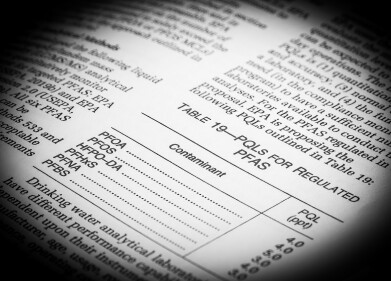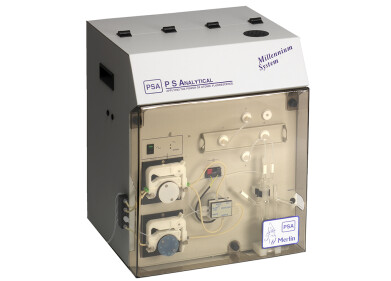Environmental laboratory
Day 1 of ICGMP 2022: Mercury Abatement, Modelling and Progress on Minamata
Jul 25 2022
Even in 2013, when it was formally ratified, the United Nations’ Minamata Convention on Mercury had a desperate sense of urgency, of having already run out of time. As one of the most harmful anthropogenic pollutants, the coordinated reduction of both exposure and emission leapt immediately to the top of the list of priorities in the management of public health worldwide. More recently, however, this urgency has become part of another global race against time, as concerns began to be raised over mercury’s role in the climate crisis. As a contribution to these discussions, this year’s International Conference on Mercury as a Global Pollutant (ICMGP), which kicked off today, will centre innovations aimed at reducing mercury emissions to achieve a greener world.
But it’s a difficult task – mercury is, worryingly, everywhere. For instance, Michael Radicone from i2 Air Fluid Innovation started off a week of discussions and presentations with a talk on tackling toxic mercury waste in dentistry. According to the Minamata Convention, mercury-based dental fillings account for around 10% of the world’s mercury use – all in all, for instance, dentistry in the United States uses around 32 tons for fillings every year. The difficulty, of course, is that all of this mercury will find its way into the environment through wastewater. Usually, amalgam separators are installed to contain this waste, but the infrastructure has a few holes. As such, Mr. Radicone’s presentation outlined some potential improvements to this system using mercuric transformative microbes.
Similarly, as Mark Seelos of the Santa Clara Council points out, aquatic sediments are another important source of environmental toxic methylmercury. It’s a fairly simple mechanism, in which certain sediments tend to encourage the growth of anaerobic bacteria that results in the methylation of any inorganic mercury that finds its way into these areas of the biosphere. Conventionally, you’ll use sediment removal or sediment capping – well, if you can afford it! Both prohibitively expensive and highly technical, these traditional methods pale in comparison to state-of-the-art in-situ treatments capable of disfavouring the process of methylation whilst increasing sorption of the toxic methylmercury to various solids.
It’s only one of the new technologies that interrupts organic toxification processes. From Central South University in Changsha, Fanyu Meng, Ph.D., outlines the concept of mechanochemical activation for vapour-phase mercury sequestration. In a number of previous experiments, metal sulphides have proven effective traps for permanent elemental mercury sequestration, as they tend to mimic the typical stabilisation process by forming ultra-stable cinnabars. Although this technique has been widely regarded for a number of years, the means of obtaining mineral sulphides have thrown up obstacles to the widespread use of this technology; fabrication is complex and involves hazardous precursors, going natural can’t deliver the necessary adsorption. Hopefully, though, Meng has the answer: modifying natural mineral sulphide with cupric chloride.
Importantly, though, even as means of abatement continue to develop, it’s best to keep an eye on prevention – and that means modelling. As a result of deforestation and climate change, around 20% of the Amazon has been lost since 1970, with an additional 40% at risk by 2050 if the trajectory holds. Interestingly, for our purposes, the Amazon is not only one of the world’s largest carbon sink but manages to capture a significant amount of atmospheric mercury, too. For MIT, Ari Feinberg, Ph.D., took the audience through all of the research aiming to model the impact that a shrinking Amazon is having on mercury sequestration. Some of Mr. Feinberg’s talk is shocking. In particular, a projection based on current practices has the Amazon converted into a net source of mercury by 2050.
There are, unfortunately, other nightmares on display. For instance, Xu Zhou, Ph.D., of the Xinjiang Institute of Ecology and Geography, discusses the increase of mercury in the topsoil of the Junggar Basin in northern Asia. The Junggar Basin plays an indispensable role in China’s energy infrastructure, but crucial coal-utilisation remains challenging by virtue of the disruptive submicron coal-ash, containing high concentrations of alkali metals and mercury, which has been accumulating in increasing numbers in recent years. Even more challenging still is the task of identifying and separating this toxic mercury waste, as it tends to ‘hide’ behind the earth-abundant elements in topsoil. However, Mr. Zhou suggest, using compositional data analysis, unsupervised anomaly-detection algorithms, non-stationary multiple-point co-simulation, and the known ratio of anhysteretic remanent magnetisation, it might just be possible.
A sliver of light, then – and there’s more where that came from. In a later session, a rousing presentation was delivered by Yaqin Guo from the Hanoi University of Science and Technology. The contention was that pursuing clean air and low-carbon policies tends to reduce the mercury emissions of coal-fired power plants, too, judging by recent results from experiments conducted in China. More good news out of China: a comprehensive inventory of China’s mercury emissions between 2000 and 2020 reveals significant reductions, reports Yang Zhang of Nanjing University. And it’s a similar story in Norway, as Hans Frederik Veiteberg of the Norwegian Institute for Water Research discussed. What’s interesting is that Norwegian regulators managed this reduction under their own auspices, pursuing their own unique regulatory path.
It’s been a whirlwind opening day, with more than twenty unique and challenging presentations from some of the world’s leading researchers, regulators and inventors working in the field of mercury pollution. Perhaps the best part, though, is that we have another four days ahead of us. It has to be said, and said again, that if you’re involved in environmental mercury, there’s really nowhere else that you should be than at ICMGP 2022.
For more information, visit the International Conference on Mercury as Global Pollutant.
Digital Edition
AET 28.4 Oct/Nov 2024
November 2024
Gas Detection - Go from lagging to leading: why investment in gas detection makes sense Air Monitoring - Swirl and vortex meters will aid green hydrogen production - Beyond the Stack: Emi...
View all digital editions
Events
Jan 20 2025 San Diego, CA, USA
Carrefour des Gestions Locales de L'eau
Jan 22 2025 Rennes, France
Safety, Health & Wellbeing LIVE
Jan 22 2025 Manchester, UK
Jan 25 2025 San Diego, CA, USA
Jan 29 2025 Tokyo, Japan



















